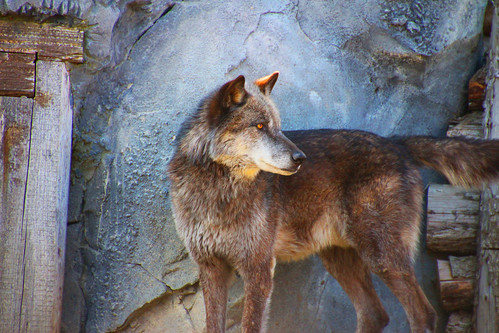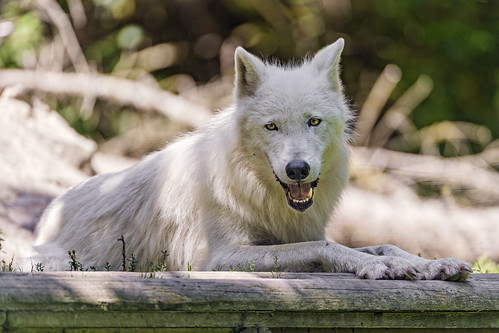
BOISE, Idaho (AP) — Organizers
of a disputed weekend predator derby in central Idaho's mountains say
21 coyotes but no wolves were shot by more than 230 hunters who
participated.
The derby near Salmon became embroiled in a fight between its organizers and environmentalists in U.S. District Court, where a judge allowed the event to proceed as planned.
Organizers of the derby argued they were seeking to publicize wolves' impact on local elk herds as well as possible disease risks with the competition, while foes including WildEarth Guardians said the event was a "wolf slaughter" that glorified the killing of an animal that just two years ago had lost protections of the Endangered Species Act through an act of Congress.
Steve Alder of Idaho for Wildlife, the derby's promoter, said the low tally helps prove sport hunting isn't a very effective tool in managing Idaho's wolves.
"This is why the Idaho Department of Fish and Game has implemented trapping and other control methods to better manage wolves," Alder said in a statement. "I can assure you that in the last two days while this derby was taking place, more wolves and wolf pups died in Idaho's back country due to starvation and or cannibalism from other wolves."
Idaho has a hunting season for wolves, as do Montana and Wyoming.
Alder's group offered two separate, $1,000 prizes — one for the hunter who killed the biggest wolf, the other for the hunter who bagged the most coyotes.
WildEarth Guardians wanted the Idaho derby scotched on grounds the U.S. Forest Service hadn't issued a special permit, but U.S. District Magistrate Judge Candy Wagahoff Dale last Friday decided no permit was needed.
After losing in court, WildEarth Guardians executive director John Hornung in Santa Fe, N.M., told The Associated Press his group plans to petition the Forest Service for changes he hopes will prevent such events.
"We're going to petition the U.S. Forest Service to update their regulations on these hunts to reflect contemporary science and public attitudes," Hornung said.
While competitive wolf shooting inflamed advocates' passions, derbies targeting other, more-common predators including foxes and coyotes across the West and much of the rest of the country generally proceed without as much public outcry.
For instance, a coyote derby planned for Jan. 11 in Dillon, Mont., will allow hunters to bag the carnivores on U.S. Forest Service and Bureau of Land Management territory, though nobody has challenged whether its organizers have followed the agencies rules.
Shelby Westphall, the organizer of the 2nd annual event in southwestern Montana, said 13 coyotes were shot at last year's event.
"These people have to go out and hunt them," Westphall told the AP. "They have to call them, they have to find them, they have to hunt them. This is true hunting."
However, wolves, which unlike coyotes are regulated by Montana Fish, Wildlife and Parks, aren't on the target list at the Dillon event. In Montana, prize money for the biggest game, including wolves, must be less than $50, said Mike Korn, Montana Fish Wildlife and Parks assistant chief of law enforcement.
The derby near Salmon became embroiled in a fight between its organizers and environmentalists in U.S. District Court, where a judge allowed the event to proceed as planned.
Organizers of the derby argued they were seeking to publicize wolves' impact on local elk herds as well as possible disease risks with the competition, while foes including WildEarth Guardians said the event was a "wolf slaughter" that glorified the killing of an animal that just two years ago had lost protections of the Endangered Species Act through an act of Congress.
Steve Alder of Idaho for Wildlife, the derby's promoter, said the low tally helps prove sport hunting isn't a very effective tool in managing Idaho's wolves.
"This is why the Idaho Department of Fish and Game has implemented trapping and other control methods to better manage wolves," Alder said in a statement. "I can assure you that in the last two days while this derby was taking place, more wolves and wolf pups died in Idaho's back country due to starvation and or cannibalism from other wolves."
Idaho has a hunting season for wolves, as do Montana and Wyoming.
Alder's group offered two separate, $1,000 prizes — one for the hunter who killed the biggest wolf, the other for the hunter who bagged the most coyotes.
WildEarth Guardians wanted the Idaho derby scotched on grounds the U.S. Forest Service hadn't issued a special permit, but U.S. District Magistrate Judge Candy Wagahoff Dale last Friday decided no permit was needed.
After losing in court, WildEarth Guardians executive director John Hornung in Santa Fe, N.M., told The Associated Press his group plans to petition the Forest Service for changes he hopes will prevent such events.
"We're going to petition the U.S. Forest Service to update their regulations on these hunts to reflect contemporary science and public attitudes," Hornung said.
While competitive wolf shooting inflamed advocates' passions, derbies targeting other, more-common predators including foxes and coyotes across the West and much of the rest of the country generally proceed without as much public outcry.
For instance, a coyote derby planned for Jan. 11 in Dillon, Mont., will allow hunters to bag the carnivores on U.S. Forest Service and Bureau of Land Management territory, though nobody has challenged whether its organizers have followed the agencies rules.
Shelby Westphall, the organizer of the 2nd annual event in southwestern Montana, said 13 coyotes were shot at last year's event.
"These people have to go out and hunt them," Westphall told the AP. "They have to call them, they have to find them, they have to hunt them. This is true hunting."
However, wolves, which unlike coyotes are regulated by Montana Fish, Wildlife and Parks, aren't on the target list at the Dillon event. In Montana, prize money for the biggest game, including wolves, must be less than $50, said Mike Korn, Montana Fish Wildlife and Parks assistant chief of law enforcement.








































